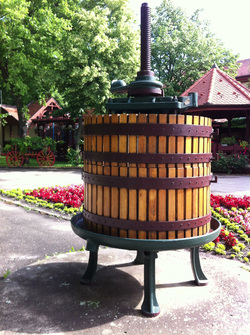 Palić shows it's history of wine
Palić shows it's history of wine The DiBonis winery produce a rather lovely Shiraz and I felt that I'd like to buy some on my return home. Sadly, this wasn't to be as they aren't for sale in the UK (yet). However, we started a conversation and with my encouragement, they entered the Decanter World Wine Awards and received a commendation for the Shiraz and a bronze medal award for their Cabernet Franc. I was given the opportunity to test some bottles on the British public at Alfred the Grape, one of my favourite local wine stores, and the reaction was pretty favourable, so let's hope we can find someone willing to import these wines so that we can share them with you, and a much wider audience. (Importers and potential vendors, please feel free to get in touch!)
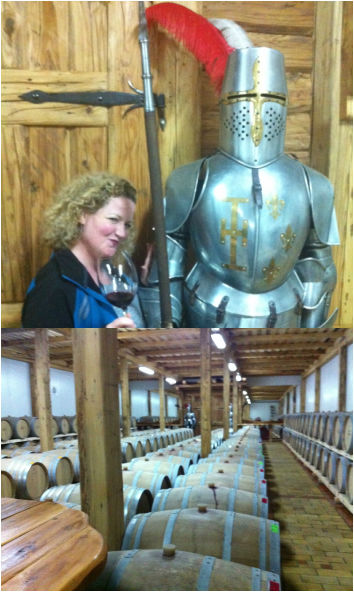 Inside the Barrique room at DiBonis
Inside the Barrique room at DiBonis The winery itself is between the lakeside town of Palić, and the larger Subotica, both of which have some interesting fin-du-siecle architecture, with much of it appearing to step straight out of the pages of Hansel and Gretel. There's a thriving tourism business based on the historic lake and spa of the region and plenty of Hungarians coming to taste the wines. The area is around 200 kilometres from Budapest and a similar distance from Belgrade. Largely unknown to us in the UK, it was a rare privilege to visit the hub of the local wine tourism route, which is the DiBonis winery, and my lodgings were in a mansion formerly used each summer by the Yugoslav President, Tito. could life get any more surreal? (Hint: yes it could...)
 Entrance to the Shiraz Tasting room, surrounded by fruit tree, and the wine treasury inside...
Entrance to the Shiraz Tasting room, surrounded by fruit tree, and the wine treasury inside... DiBonis are a premium wine producer in the area, but are perhaps even more renowned for their traditional fruit brandy products, known as Pálinka in Hungary, where that name has a PDO status. These are made from a large variety of fruits including apple, pear, quince, plum, muscat grape, raspberry, strawberry, apricot and more, all grown locally and distilled with the finest care under the guiding hand of Laszlo Boni, the owner and general alcohol producing genius at DiBonis. This genre of spirits is not one I've had a lot of contact with, though had I tasted these before, I may have been tempted. They also make a Calvados style Apple Brandy called Almados which could surely fool those from Normandy, just as Japanese whisky recently had me wondering if I could tell it from Scotch.
 A selection of the different types of fruit brandy made by DiBonis with world cup labels on the neck for winning products. Side by side 2 types of raspberry flavour - one the pure distillate, and the other then allowed to sit on partially dried residue for a number of weeks
A selection of the different types of fruit brandy made by DiBonis with world cup labels on the neck for winning products. Side by side 2 types of raspberry flavour - one the pure distillate, and the other then allowed to sit on partially dried residue for a number of weeks 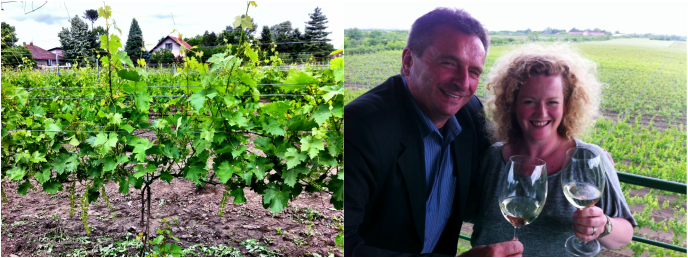 Grapevines grow while Mr Boni and I share some post lunch, demi-sec Muscat in the tower from which he can see all his vines
Grapevines grow while Mr Boni and I share some post lunch, demi-sec Muscat in the tower from which he can see all his vines Laszlo grew up in a family with a wine tradition, surrounded by vineyards, but he didn't follow in his father's footsteps and instead pursued a technical career. However, the lure of the vine, called him back around his mid-40s when he went back to his roots and set up DiBonis. He's hoping his own two sons will carry on the tradition without such a long break! Not that he has any intention of quitting the business any time soon. Serbian wine law dictates that all wineries must employ someone with a oenology degree. Rather than hiring someone qualified to make his wines for him, Laszlo decided that he'd take the degree himself, and, at the age of 58, was in celebratory mood when I arrived, as he'd just finished his final exam on that very day. It's clear he's passionate about sharing his wines with an appreciative audience, and while he used the latest techniques and equipment to control the wine making processes, with his engineer's eye, he also has a creative side that's led him to experiment with grapes not commonly grown in the area, with different techniques, and with blends "just to see what will happen". For example, I tried a 2009 blend in American oak of 2/3 Shiraz and one third Vranac (a powerful local grape, which produces dark, inky wines that respond well to oak). Despite it's age, this wine will still benefit from more time in the barrel, and probably from some bottle age too. Both wines on their own are dark, powerful and spicy, yet together they create something new.
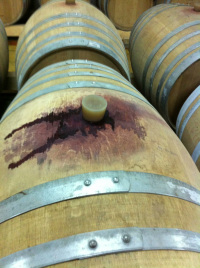 A barrel with "wine bleed"
A barrel with "wine bleed" As with the fruits for the brandies, it's fair to say that the grapes at the centre of production really benefit from the warm Serbian summers and the local soils. With high quality fruit, it's much easier to make high quality wines and spirits.
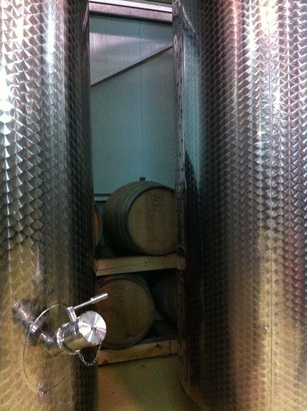 Well concealed Cabernet Sauvignon
Well concealed Cabernet Sauvignon 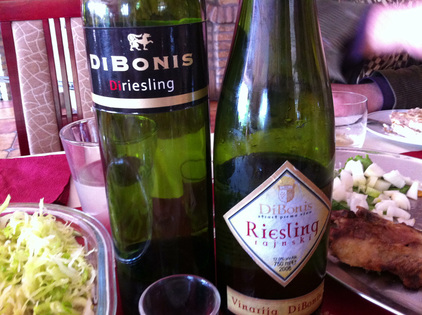 Two rieslings enjoyed with dinner, showing the old and new DiBonis branding
Two rieslings enjoyed with dinner, showing the old and new DiBonis branding This takes the philosophy to the next level, that aside from just the growth cycle, products like wine "live on" long after they've been bottled. Winemakers, buyers and enthusiasts around the world are starting to appreciate subtle differences in the way a wine tastes when consumed on leaf, root, flower or fruit days. Have you ever noticed that you really enjoy a bottle of wine so the next day you open another bottle of the same batch only to be a little disappointed? This is the kind of phenomenon which has reputedly led Sainsbury's and Tesco to run tastings according to the biodynamic calendar.
If you're intrigued, then you can run some tests at home yourself. There's a calendar here that tells you whether it's a root, fruit, leaf or flower day. Root and leaf days are best avoided while fruit and flower days are much more favourable. The good news is that from 8:32pm tonight, (June 6th 2013) till 9.30pm on Sunday are all flower days so get those aromatic wines opened this weekend and you're purportedly in for a treat. I may have to do some experiments of my own if only to find a few days where I shouldn't be drinking wine! More on this another day, perhaps.
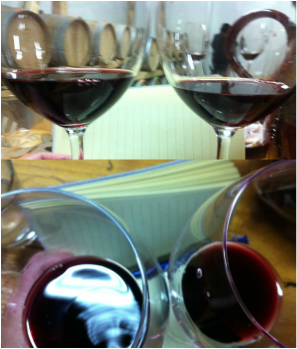 American versus Hungarian Oak Merlot - spot the difference?
American versus Hungarian Oak Merlot - spot the difference? I also tasted 2 Merlots from 2008, again side by side, and again from the 2 different types of oak barrel. In this case, being a much easier drinking grape, the wines were much closer to being ready for drinking and you could really start to tell how the American oak opens up more readily, allowing the wine to age somewhat faster than the Hungarian, and creating a very smooth drinking Merlot, with the Hungarian one adding a much more spicy note to the traditional plum flavours. You may have gathered from my previous posts that I'm not much of a Merlot drinker, but I could be persuaded if more were like this. Smooth, and easy drinking, but not overly simple. Was it a trick of the light that I also thought the colours were slightly different? Perhaps so, as my iphone couldn't pick up any discernible difference, but it had been a long day.
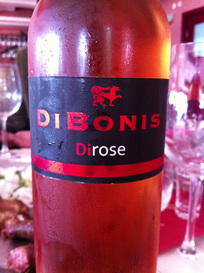
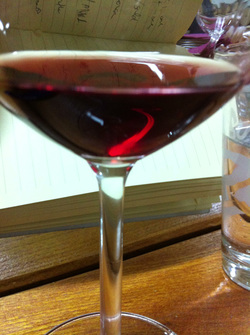 A beautiful Pinot Noir
A beautiful Pinot Noir Next to this, we tried a Bordeaux style blend direct from it's 2012 (American oak) barrel. Clearly this blend of Merlot, Cabernet Franc and Cabernet Sauvignon was going to be young, but what was intriguing here was the fact that all of the grapes were blended together right at the fermentation stage, where they went in for a long, cold fermentation of around 4 days with the skins left in contact for 10-11 days.
From the bottle, I was also able to try another experiment, and a very pleasing one. At the request of a Belgrade wine merchant, DiBonis have produced a trial blend of 50% Merlot, 50% Cabernet Sauvignon. In this case, the sum of the parts was definitely worth more than the individual grapes can be, at least for my palate. Hopefully, this will be something that's not just available to that one wine merchant!
 In production and the finished article: Carp Soup. The Almados was a fitting aperitif on a cold, wet night
In production and the finished article: Carp Soup. The Almados was a fitting aperitif on a cold, wet night I can't thank the DiBonis team enough for the welcome, I received, and I hope I've left my readers with a thirst to try some new wines from a region they may not previously considered. If you're interested in distributing any or all of the DiBonis portfolio in the UK, then please get in touch! And if you're looking for an unusual holiday destination, then consider the flat landscape of Subotica. The wine tourism is a lot of fun! And if you've not got enough information here, you'll find more photos on my Facebook page. Remember to "like" it to get all the latest on what we're drinking now.
As for how life got more surreal, after leaving the vineyards behind, I headed back to Budapest to participate in the Hungarian Open west coast swing dance championships, where I competed in Open Strictly with a hair stylist from Finland on the Friday night, still with somewhat of a fruit brandy hangover! On the Saturday, I ended up placing 4th in the Novice Jack and Jill with a chap from Minsk in Belarus, after having shared my dance philosophy in a dance psychology class with a group from Hungary, Poland, France, Russia and more. At this stage, I have no regrets about abandoning my corporate career for a life of wine, dance and adventure. It's been amazing. Thank you for reading and sharing in it with me.
Cheers!
UPDATE:
If you're interested in visiting the DiBonis Winery, a small travel company (e-mail: [email protected] www.metropoliten.com www.travelserbiabelgrade.com) has put together the following programme. Please note this has no association with Purple Teeth.
Accomodation: Hotel President Palic ( ****)Spa and wellness hotel.
First day
Arrival 17.00-18.00 to Hotel president Palic
Transfer to DiBonis Winery with coach, 18.30
- 19.00 Dinner at shiraz degustation centre with live music, and local specialities, limitless consumption of DiChardonnay , DiRose and DiMerlot wine, during dinner.
- 20.30 degustation of award winning DiBonis White and rose wines. ( Riesling , sauvignon blanc, chardonnay, muscat and rose wines, in the barrique chamber.
- 22.30 transfer back to the hotel.
Second day
- Spa and brekfast Till 10.00 am.and walking Tour to the lake Palic .
-10.15- 12.15 boat trip on the lake Palic, with live music and rose wine. Guided Tour of Palic and area.
- 12.30-14.30 transfer from the hotel to the lunch at the Shiraz degustation centre with limitless wine consumption ( chardonnay and merlot)
- 14.45-18.00 transfer to the Hotel and free activities at lake Palic and in the Spa and Welness centre of the hotel President.
- 18.10 transfer from the hotel to the Jurta at the wineyards, where with the taste of burek our guests will try 6 different types of fruit brandies ( rakija)
- 19.30 transfer to the Shiraz degustation centre.
- 19.30 Dinner with live music and Fish soup .
-20.45 Red wine degustation at the barrique chamber of the DiBonis Winery
- 22.30 transfer back to the hotel!
Day three
- Spa and brekfast Till 10.00 am
Price in Euro per person 170 - based on min. 30 passengers
Included in the price:
·Transfers per program
·Accommodation in double/single rooms on .........basis
·Sightseeings tours as per program, English speaking guide ,
·Degustations of wine and Rakia per program,
·Dinner x , Lunch x Breakfast
·Glob Metropoliten Tours welcome gift,
·Agency support 24/7
Not included :
·Air ticket or other transportation
·Personal expenses
·
"GLOB METROPOLITEN TOURS-LUFTHANSA CITY CENTER,Beograd, Makenzijeva 26, tel/fax:381/11 -2430 899
e-mail: [email protected] www.metropoliten.com www.travelserbiabelgrade.com
Licence OTP 133/2010. - 05.02.2010.





 RSS Feed
RSS Feed
